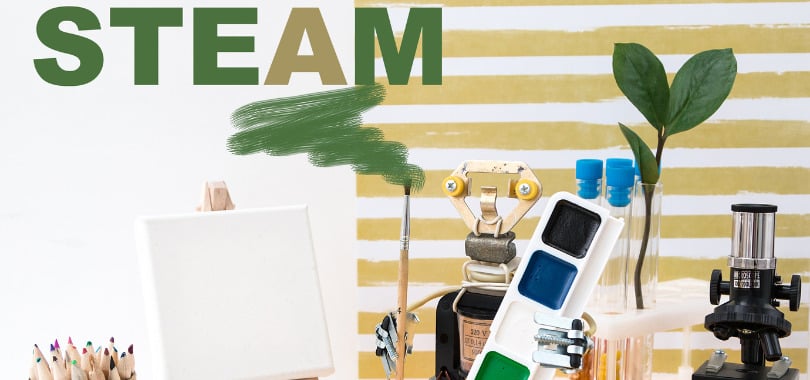You’re likely familiar with STEM, which stands for Science, Technology, Engineering and Math – but what about STEAM curriculum? It’s very similar, but the A actually stands for Art! But what exactly is STEAM, and what are the benefits of adding Art to the mix? Keep reading to find out!
What is STEAM
STEAM stands for Science, Technology, Engineering, Art, and Math. When used in the classroom, it is meant to promote hands-on learning with practical applications in the real world.
STEAM vs STEM
Aside from the obvious added “Art” in STEAM, there are differences between STEAM and STEM, mainly how they approach scientific concepts. STEM focuses on “hard” skills, while STEAM embraces hard and soft approaches. An example of how STEAM works in the real world would be 3D printing. It uses hard concepts combined with soft skills to develop a form of art.
What Does STEAM Curriculum Include?
STEAM classes can have very similar classes to STEM, with the program lasting from elementary school through high school. Courses and classes focus on:
- Problem-solving
- Group challenges
- Communication skills
- Teamwork skills
- Brainstorming
- Testing
- Building
- Designing
What Does ART in STEAM Refer To?
Art in STEAM refers to a few different categories, including:
- Fine arts. Such as drawing and painting
- Language arts. Including English and foreign languages
- Physical arts. Including dance and athletics
- Liberal arts. Such as sociology, history, and civics
- Manual arts. Including architecture and landscape design
Why is Art Included in this Version of STEM?
The skills learned in STEM programs are no doubt valuable. They are in high demand in the workforce, and students who excel in these areas can problem solve, understand complex issues, and more.
Art in STEAM, however, brings another layer to those problem-solving abilities. Creative solutions can also solve issues or concerns, something that may be lacking in education under STEM. The arts can aid with different perspectives, communication, accessibility, creativity, and contemplation, all of which have a significant impact on how an individual approaches a problem in the first place.
What are the Benefits of STEAM?
In addition to problem-solving and teaching students the hard and soft skills they need to succeed in the real world, STEAM brings a number of other benefits to the table, including:
1. Computational Thinking Skills
Computational thinking skills help students better understand coding before they even begin. It refers to the ability to formulate an issue and express the solution to a computer – in a way the computer will understand and be able to use.
2. Technology Literacy
Even though they’ve grown up in a world full of technology, many students lack the ability to use technology to its full potential. Students in a STEAM program will be able to get the most out of tech, computers, and engineering, while also learning about implementing these skills in the real world. In addition, they will be able to understand why those skills are so important.
3. Critical Thinking
STEM and STEAM help with critical thinking skills, but STEAM also helps students look at problems from different angles. Programs and assignments will present issues that can be solved in several different ways, so the student can apply knowledge from a multitude of areas in order to get to an answer. They can pull lessons from different areas, such as art and science, to solve the issue at hand.
4. Improved Collaboration, Communication, Social, and Leadership Skills
Thanks to the group work in STEAM courses, students can better collaborate and communicate with others on their team. This translates well in the real world as professionals rarely work solo, but rather as part of a business or organization. In addition, communication and empathy can be improved by helping them practice working together.
And, of course, someone will be the “leader” in the group, whether they’re assigned that role or it comes naturally. This experience helps students learn to better manage time, resources, and their own contribution to the group and assignment.
STEAM is a very engaging program for students. Not only does it teach them the skills they need from STEM, but it teaches them how to apply those hard skills in more creative ways. Graduates from high school can take those lessons into college and the professional world to develop new, innovative ways to solve problems.
Are you thinking about majoring or pursuing a career in a STEAM-related field? It’s important to understand what to expect! College Raptor’s Major Search tool and Career Finder can help you locate the majors and careers you need in order to achieve your dreams. You’ll even find lists of some of the best schools, salary expectations, and more using these two resources.
*Source: (artsintegration.com)




